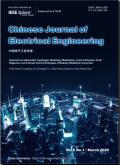Review of Control Techniques for Interleaved Buck Converters: Control Strategies, Efficiency Optimization and Phase Shedding*
IF 3.5
Q1 Engineering
引用次数: 0
Abstract
High-performance microprocessors have rapidly evolved and become ubiquitous in modern society. However, their power supply has become a significant factor limiting their overall performance. A power delivery module, known as a voltage regulator module (VRM), is required to provide high voltage, low current, and a fast transient response to meet microprocessor demands. An interleaved parallel-buck converter is suitable for VRM applications. Selecting an appropriate control strategy for the interleaved converter can help achieve high precision and fast response, thereby optimizing performance. First, the operating principles of interleaved parallel converters are analyzed. The relationship between the number of phases and conversion efficiency is also examined. Subsequently, commonly employed control techniques for interleaved converters are reviewed, discussing their respective advantages and limitations, along with an analysis of their suitability for phase-shedding strategies. A phase-shedding technique for interleaved converters is then introduced. Finally, the shortcomings of current control approaches for interleaved buck converters are outlined, and potential future research directions are suggested. These insights aim to enhance control performance and advance practical engineering applications.交错降压变换器控制技术综述:控制策略、效率优化和减相
高性能微处理器迅速发展,在现代社会中无处不在。然而,它们的电源供应已经成为限制其整体性能的一个重要因素。电源输出模块,即稳压模块(VRM),需要提供高电压、低电流和快速瞬态响应,以满足微处理器的需求。交错并联降压变换器适用于VRM应用。选择合适的交错变换器控制策略可以实现高精度和快速响应,从而优化其性能。首先,分析了交错并联变流器的工作原理。还研究了相数与转换效率之间的关系。随后,回顾了常用的交错变换器控制技术,讨论了它们各自的优点和局限性,并分析了它们对减相策略的适用性。然后介绍了一种用于交错变换器的减相技术。最后,总结了当前交错降压变换器电流控制方法存在的不足,并对今后的研究方向提出了建议。这些见解旨在提高控制性能并推进实际工程应用。
本文章由计算机程序翻译,如有差异,请以英文原文为准。
求助全文
约1分钟内获得全文
求助全文
来源期刊

Chinese Journal of Electrical Engineering
Energy-Energy Engineering and Power Technology
CiteScore
7.80
自引率
0.00%
发文量
621
审稿时长
12 weeks
 求助内容:
求助内容: 应助结果提醒方式:
应助结果提醒方式:


